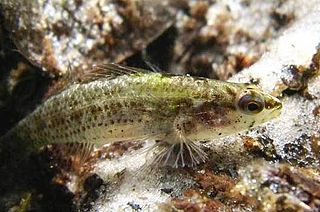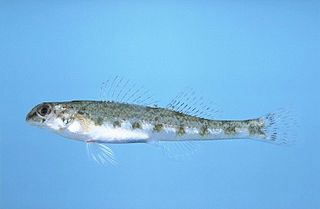
Etheostoma is a genus of small freshwater fish in the family Percidae native to North America. Most are restricted to the United States, but species are also found in Canada and Mexico. They are commonly known as darters, although the term "darter" is shared by several other genera. Many can produce alarm pheromones that serve to warn nearby fish in case of an attack.

The watercress darter is a species of freshwater ray-finned fish, a darter from the subfamily Etheostomatinae, part of the family Percidae, which also contains the perches, ruffes and pikeperches. It is endemic to the eastern United States where it is only known from the Black Warrior River drainage basin near Birmingham, Alabama.

The Okaloosa darter is a species of freshwater ray-finned fish, a darter from the subfamily Etheostomatinae, part of the family Percidae, which also contains the perches, ruffes and pikeperches. It is indigenous to freshwater streams and tributary systems in Okaloosa and Walton Counties in northwest Florida.
The spotted darter is a species of freshwater ray-finned fish, a darter from the subfamily Etheostomatinae, part of the family Percidae, which also contains the perches, ruffes and pikeperches. It is endemic to the eastern United States where it occurs in the basin of the Ohio River. It inhabits fast-flowing rocky riffles of medium-sized and smaller rivers. This species can reach a length of 9 centimetres (3.5 in) TL though most only reach about 5.5 centimetres (2.2 in).
The Bayou darter is a rare species of freshwater ray-finned fish, a darter from the subfamily Etheostomatinae, part of the family Percidae, which also contains the perches, ruffes and pikeperches. It is endemic to western Mississippi in the United States, where it is found only in Bayou Pierre and its tributaries. Its typical habitat is fast-flowing creeks and streams, in riffles and in areas between riffles with firm gravel bottoms. It feeds on small insects and their larvae. Breeding probably takes place twice a year, in spring and late summer. The population of this fish is declining due to loss of suitable habitat. This is caused by siltation and pollution, particularly erosion caused by changes in land use. The International Union for Conservation of Nature has assessed its conservation status as being "endangered".

The Coosa darter is a species of freshwater ray-finned fish, a darter from the subfamily Etheostomatinae, part of the family Percidae, which also contains the perches, ruffes and pikeperches. It is endemic to the eastern United States.
The golden darter is a species of freshwater ray-finned fish, a darter from the subfamily Etheostomatinae, part of the family Percidae, which also contains the perches, ruffes and pikeperches. It is found in the upper Tennessee River, one of the over 300 fish species found in Tennessee.
The goldstripe darter is a species of freshwater ray-finned fish, a darter from the subfamily Etheostomatinae, part of the family Percidae, which also contains the perches, ruffes and pikeperches. It is endemic to the southeastern United States where it is found in Gulf Slope streams from the Colorado River drainage in Texas to the Flint River in Georgia, the Atlantic Slope in Ocmulgee River system, Georgia, and the Mississippi embayment north as far as southeastern Missouri and western Kentucky. It is typically found in small springs, streams, and creeks with aquatic and marginal vegetation and detritus. The female spawns on multiple occasions between about mid-March and June, sticking the adhesive eggs to plants, gravel and the sides of rocks. The goldstripe darter is a common species with a wide range and numerous sub-populations, and the International Union for Conservation of Nature has assessed its conservation status as being of "least concern".
The cypress darter is a species of freshwater ray-finned fish, a darter from the subfamily Etheostomatinae, part of the family Percidae, which also contains the perches, ruffes and pikeperches. It is endemic to fresh waters of the central and eastern United States. Its range includes drainages from the Choctawhatchee River, Florida, to the San Jacinto River, Texas, as well as the Mississippi River basin from southern Illinois and eastern Oklahoma to the Gulf of Mexico. It inhabits vegetated margins of swamps and lakes, and backwater habitats during the summer, while in winter it moves to flooded riffles and backwater bayous. It feeds mostly on small crustaceans, as well as insects and their larvae. Spawning takes place during spring and summer, with clusters of up to three eggs being laid, often stuck to the surface of dead leaves. The cypress darter has a very wide range and its population trend seems to be stable. It is a common species with numerous sub-populations, and the International Union for Conservation of Nature has assessed its conservation status as being of "least concern".
The Cumberland darter is a rare species of freshwater ray-finned fish, a darter from the subfamily Etheostomatinae, part of the family Percidae, which also contains the perches, ruffes and pikeperches. It is endemic to Kentucky and Tennessee in the United States, where it occurs in the upper Cumberland River tributaries above Cumberland Falls. It was federally listed as an endangered species in the US on August 9, 2011.

The longfin darter is a species of freshwater ray-finned fish, a darter from the subfamily Etheostomatinae, part of the family Percidae, which also contains the perches, ruffes and pikeperches. It is endemic to the eastern United States, where it occurs in the upper James River drainage in Virginia and West Virginia. It inhabits rocky riffles of creeks and small rivers. This species can reach a length of 8.9 cm (3.5 in).
The riverweed darter is a species of freshwater ray-finned fish, a darter from the subfamily Etheostomatinae, part of the family Percidae, which also contains the perches, ruffes and pikeperches. It is endemic to the eastern United States, where it occurs in the upper Roanoke River drainage in Virginia and North Carolina. It inhabits rocky riffles of creeks and small rivers. This species can reach a length of 7.6 cm (3.0 in).
The Kentucky darter is a species of freshwater ray-finned fish, a darter from the subfamily Etheostomatinae, part of the family Percidae, which also contains the perches, ruffes and pikeperches. It is endemic to the eastern United States, where it occurs in the upper Green and Gasper River systems in Kentucky. It inhabits rocky pools and adjacent riffles of creeks and small rivers. It has a diet that mainly consists of mayflies, larval blackflies, midges and occasionally various insect larvae. This species can reach a length of 6.5 cm (2.6 in).
The Missouri saddled darter is a species of freshwater ray-finned fish, a darter from the subfamily Etheostomatinae, part of the family Percidae, which also contains the perches, ruffes and pikeperches. It is endemic to Missouri, where it occurs in the Ozarks from the Gasconade River to the Osage and Moreau rivers. It occurs in fast gravel and rubble riffles of small to medium rivers. This species can reach a length of 9.0 cm (3.5 in).
The strawberry darter is a species of freshwater ray-finned fish, a darter from the subfamily Etheostomatinae, part of the family Percidae, which also contains the perches, ruffes and pikeperches. It is endemic to the eastern United States, where it occurs in includes upland headwaters of the Strawberry River in Arkansas. It inhabits shallow gravel riffles, rocky runs, and pools of headwaters, creeks, and small rivers.
The current darter is a species of freshwater ray-finned fish, a darter from the subfamily Etheostomatinae, part of the family Percidae, which also contains the perches, ruffes and pikeperches. It is endemic to the eastern United States. This fish occurs in the Black River drainage system from south central Missouri to north central Arkansas, where it is found in shallow gravel riffles, sometimes rocky runs and pools of headwaters and creeks.
The Alabama darter is a species of freshwater ray-finned fish, a darter from the subfamily Etheostomatinae, part of the family Percidae, which also contains the perches, ruffes and pikeperches. It is endemic to the eastern United States, where it occurs mostly below the fall line of the Alabama River drainage. It is also relatively common in headwater tributaries to the Cahaba River above the fall line.

The coastal darter is a species of freshwater ray-finned fish, a darter from the subfamily Etheostomatinae, part of the family Percidae, which also contains the perches, ruffes and pikeperches. It is endemic to the eastern United States, where it occurs in the Gulf Coastal Plain from the Choctawhatchee River to the Perdido River in Alabama and Florida. It inhabits sand and gravel bottomed pools of headwaters, creeks, and small rivers.
The Tuskaloosa darter is a species of freshwater ray-finned fish, a darter from the subfamily Etheostomatinae, part of the family Percidae, which also contains the perches, ruffes and pikeperches. It is endemic to Alabama in the United States, where it occurs only in the upper Black Warrior River drainage, with disjunct populations occurring in the Locust Fork system and upper Sipsey Fork systems.
The Tombigbee darter is a species of freshwater ray-finned fish, a darter from the subfamily Etheostomatinae, part of the family Percidae, which also contains the perches, ruffes and pikeperches. It is endemic to the eastern United States, where it occurs in the Tombigbee River system in northeastern Mississippi and Alabama. It inhabits sand- and rock-bottomed pools of headwaters, creeks, and small rivers, and small streams with mixed sand-gravel substrate, and creeks with mixed sand, gravel, and hard clay or bedrock substrate. The Tombigbee darter was first formally described in 1994 by Royal Dallas Suttkus and Reeve Maclaren Bailey with the type locality given as Wolf Creek, a tributary to the Little Souwilpa Creek near Alabama State Route 17 in Choctaw County, Alabama.






